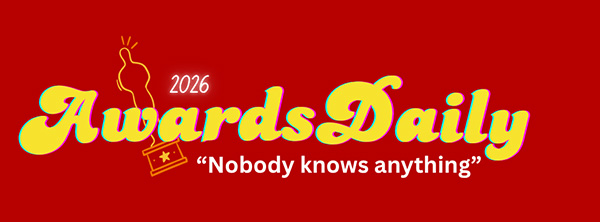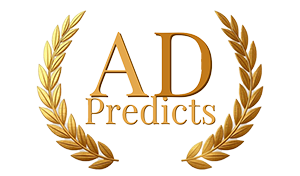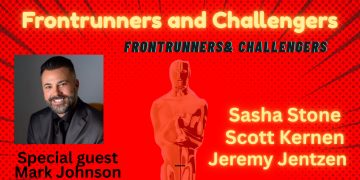Still: A Michael J. Fox Movie is a slice of movie magic. And our magician is Michael J. Fox, a once-in-a-generation talent whose natural charisma jumps through every frame.
In the hands of Davis Guggenheim (the Oscar winner behind the groundbreaking An Inconvenient Truth) and editor Michael Harte, the documentary cleverly blends interviews with Fox, reenactments, and clips from Fox’s expansive film and television work. Moving at a blistering speed, the editing blurs the line between archival footage and recreation, taking the audience for a wild ride, reminiscent of the films that made Fox a star.
Here in an interview with Awards Daily, Guggenheim and Harte discuss Still— the unique storytelling devices used in the documentary, their love of Fox’s work, building a close bond with the actor, and telling the story of Michael J. Fox with candor, humor, grace, and humility.
Awards Daily: I’ll start with my most pressing question: how did you get the idea to present Michael’s life and career using his film clips?
Davis Guggenheim: Well, to start at the beginning, that was never on my mind. The first instinct was to make less of a documentary and more of a 1980s movie where you’re on a wild ride. So, my first instinct was no on-camera interviews and just get lost in some of the traditional archives and recreations. But then Michael Harte came along, an uber Michael J. Fox fan, and he started to do things that surprised me.
Michael Harte: Yeah. I knew his movies inside out—Back to the Future and Teen Wolf; that period in the eighties when he was on the rise, that was my childhood watching those movies.
But I have worked on documentaries before where I’ve used recreations, and sometimes they’re successful, and sometimes they’re not. What I knew from working on those was that if you lean into recreation you often can’t show their face. You have to show the back of their head for various reasons, but in this case, it’s Michael J. Fox, he’s the most famous person in the world. You’re just not going to get away with just showing the back of his head. And it was a problem. We didn’t know how it would work or how we would visualize this story because Davis wanted to keep the audience guessing. So, it’s not like we were going to abandon the recreation.
And one day, I just started playing with a piece of material in the edit and took a bit of audio where Michael’s talking about getting the Back to the Future script, and I remembered a clip that I’d seen. I’d watched all his movies up to that point. Davis had given me time to review all his films again and refresh. And there was a scene where he was reading this piece of paper, and he flicked the paper. I was like, ‘Let me just try this.’ So, I took the audio and the picture and put it together. It was cool when those two things married together, where he’s talking about reading the Back to the Future script, and you see him read a script from another movie, and we’re repurposing the clip.
Then I took the music from Back to the Future and just added that little tinkle; I don’t know if you’re familiar with it; it signals that this is Back to the Future. So, when those three things came together, I said, “This could work.” I’m a Back to the Future geek so I thought maybe I’d be the only one who appreciated it. I sent it to Davis in L.A., he woke up in the morning, and thankfully, he said, “Let’s do this; this could be one way to tell a big part of our story.” And we were off to the races from then on.
DG: And I remember at SXSW when that music cue came on, there was this group inhale.
MH: I’m so annoyed I didn’t make it to SXSW. I missed it. We had just had our second baby two days before. But I gathered it was amazing, and the vibe in the theater was incredible.
AD: Well, I’m sad you didn’t make it to Austin, but congratulations! That seems like a very good excuse to miss a film festival.
MH: I would say!
AD: Michael, Still relies heavily on your editing, and it’s quite precise. For example, I loved the moment Michael J. Fox talks about meeting his wife, Tracy, and the film cuts to their characters being introduced on Family Ties. I found the blend of archival footage and reenactments innovative and compelling. It’s movie magic. It really is. Take me into the editing room with you as you made those cuts.
MH: [Laughs]. Thank you! I hate to be boring about it, but it was all about being organized and knowing the material inside out. Normally the edit will start two-thirds into the process, but Davis pulled off a really good trick: in Back to the Future fashion, let’s start at the end with the edits. So that was a unique thing for me as an editor. And I think the film is unique because of it. We listened to all of Michael’s audiobooks, which were two hours of his story without any pictures, and used that as a starting point and built an arc. When I knew what that arc was, I went off, started playing with material, and thought, ‘How could we visualize different scenes?’ Once we cracked that scene where he gets the Back to the Future script, I knew I could go and look through his movies and kind of know what we’re looking for. But I spent seven, eight weeks just going through archival footage of Back to the Future, Teen Wolf, you name it. Everything from Spin City, everything from Family Ties, and we had an archive producer on it as well, Jackie Clary, who got all that material and had an assistant for help as well. And, as I was watching different clips, I’d get new ideas. I did it for seven weeks. I was so disciplined. I didn’t do any cutting. I was just watching clips. But every so often, I’d get tired of watching material, and I’d just take a scene and play with it just to kind of mess around. I wouldn’t show it to anyone because I was kind of nervous about what we were trying to do.
Then, it was just a matter of picking a scene and going, ‘Okay, how can we visualize this?’ By that stage, after seven or eight weeks, I have a good memory for remembering everything; anytime we hit a scene, in the back of my mind, I would have 10 or 15 options, and we would try different things. The key was Davis finding a guy in Barcelona who did our storyboards.
DG: I worked with our storyboard artist on He Named Me Malala. But I would say it was just trial and error. And sometimes, I had terrible ideas about the script that Michael Harte would throw out. And then, sometimes, he tried pretty outlandish things.
MH: Terrible ideas.
DG: The spirit of it is, try anything. We have a practice of just roughly cutting for two weeks, screening what you have, and then cutting for two weeks and seeing what you have. And over that time, you start to see what works and what doesn’t. For a long time, it was either or, a recreation or footage, and then suddenly it became both.
If you look at that sequence where Michael’s doing both Family Ties and Back to the Future, it’s using both in a way in which, by the end, people get confused. I’ve had people say, ‘How did you find footage of him getting dressed backstage at Family Ties? And, it’s like, ‘No, we shot that later.’ If the storytelling is right, the audience will take a leap; the audience just goes for it.
MH: Sometimes I went too far with it and footage in moments in the movie where we shouldn’t be using it. You know, when he was diagnosed with Parkinson’s, I have scenes of him walking down the street, and it just didn’t sit right. Sometimes it just didn’t work.
AD: Davis, Michael was very clear that he didn’t want this film to be a Parkinson’s sob story. Tell me about your relationship and the bond needed to make such a personal film. I believe that Michael suffered a fall while you were filming. Did that impact production?
DG: Well, I’ve never had someone just be so totally open and willing right away. I’ve been lucky to work with people who are just wonderful, but there’s always trust building. Even your best friend, the first ten times you meet them, you’re still learning who each other is and starting to understand how they are. That was not the case with Michael J. Fox. He liked my movies, and he was excited from the beginning. The hard part was that the year we were shooting was one of his worst medical years; he broke two shoulders. He shattered his elbow. He broke his hand and had pins put in his hand; he broke his cheek, he had pins put in his cheek. He was in emergency rooms for a good part of that year. So as a production, we just had to be flexible around him. But we were fine. I mean, when he was on camera, he was so good. Michael [Harte] and I just couldn’t believe how great he was.
Because sometimes when his meds aren’t right, his energy’s not great, or he’s a little hard to understand, but when the camera was on, even the people around him were like, ‘Wow, we’ve never seen him like that.’ I think there’s something about Michael as a performer: when that camera was in the room, he just came alive.
AD: What’s your favorite shot or moment in the film?
DG: There’s a shot of a coffee machine…
MH: [Laughs]
DG: …Which is beautifully backlit. And there’s a close-up time-lapse of it filling up with coffee. And I bring that up because the worst fight Michael Harte and I ever had was over that shot. I spent an hour shooting that one shot because there was a time-lapse on it. And then when we got back to the editing room, Michael [Harte] is like, ‘Well, you couldn’t shoot it the way we storyboarded it?’ And I’m like, ‘What?’
I’m proud of myself for fighting for that shot. [Laughs].
MH: We’re joking, but there I something to glean from, which is, when you watch the film, it was deceptively complicated to make. It was really hard to make; it took a long time and a lot of trust. And of all the things me and Davis could have fallen out about, creatively, it was one shot of a coffee maker.
AD: [Laughs].
DG: I have a good answer for you.
The film was essentially finished. We screened it enough times, and it felt like it was finished. And then I think Michael Harte and I both looked at it and said, ‘There’s something missing.’ And it was this idea that Michael [J. Fox] has this optimistic attitude toward life. He’s very upbeat, but I had never challenged him on this idea. He never talks about his pain. It’s not a particularly clever piece of storytelling, but it’s a moment where I push him further than I was comfortable pushing him. So, I interview him, and then we go to that last therapy scene with his trainer, Ryan, who is extraordinary. And Michael confesses, he goes, ‘I’m tired of being Michael J. Fox sometimes.’
And the film was done. It worked; it checked all the boxes. But there’s that moment, I think, when you look at your own film, and you want to take it one step further. There’s one nagging question in your mind that you can’t let go of. So, we flew back to New York and asked that question; his answer was incredible. Michael is incredible. He just sits there and says, ‘I’m in a tremendous amount of pain.’ So I say, ‘Why didn’t you talk about it for hours and hours?’
And he goes, ‘It didn’t come up.’
MH: He’s incredible. That, to me, is the strongest scene in the film, that moment.
AD: During the post-screening Q&A at SXSW, there were so many people who wanted to share their personal stories with Michael—tell him about loved ones they had lost to Parkinson’s or their medical difficulties.
Davis, how do you feel knowing your film has struck such a deep emotional cord? And how does it feel to be in those spaces with people sharing td their love and respect for Michael?
DG: Well, I remember that from SXSW, it was a Q&A, but there was very little Q. People were so passionate, and all they wanted to do was share their story with Michael J. Fox. That’s what is so remarkable about this movie coming out. There’s so much love for this guy, this unexpected hero. He was a short kid from Canada who wanted to be famous. He wanted money, he wanted a Ferrari, and then life throws him this curve ball, and he responds in a unique way. And I think people are very moved by that. So, it’s less about us.
It’s more about how Michael Harte and I have brought him to the world, and that’s the gratifying thing.
Still: A Michael J. Fox Movie is streaming now on Apple TV+.
















